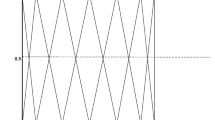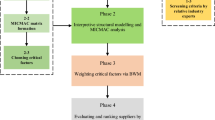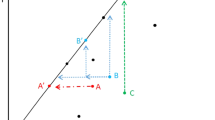Abstract
Companies are under pressure to re-engineer their supply chains to ‘go green’ while simultaneously improving their resilience to cope with unexpected disruptions where the supplier selection decision plays a strategic role. We present a new approach to supplier evaluation and allocating the optimal order quantity from each supplier with respect to green and resilience (gresilience) characteristics. An integrated framework that considers traditional business, green and resilience criteria and sub-criteria was developed, followed by a calculation of importance weight of criteria and sub-criteria using analytical hierarchy process (AHP). We evaluate suppliers using the technique for order of preference by similarity to ideal solution (TOPSIS). The obtained weights from AHP and TOPSIS were integrated into a developed multi-objective programming model used as an order allocation planner and the ε-constraint method was used to solve the multi-objective optimization problem. TOPSIS was applied to select the final Pareto solution based on its closeness from the ideal solution. The applicability and effectiveness of the proposed approach was illustrated using a real case study through a comparatively meaningful ranking of suppliers. The study provides a helpful aid for managers seeking to improve their supply chain resilience along with ‘go green’ responsibilities.




Similar content being viewed by others
Abbreviations
- TGR:
-
Traditional green resilience
- QFD:
-
Quality function deployment
- ANP:
-
Analytic network process
- ANN:
-
Artificial neural network
- DEA:
-
Data envelopment analysis
- FAD:
-
Fuzzy axiomatic design
- VIKOR:
-
VIseKriterijumska Optimizacija I Kompromisno Resenje
References
Aissaoui, N., Haouari, M., & Hassini, E. (2007). Supplier selection and order lot sizing modeling: A review. Computers & Operations Research, 34(12), 3516–3540.
Akman, G. (2015). Evaluating suppliers to include green supplier development programs via fuzzy c-means and VIKOR methods. Computers & Industrial Engineering, 86, 69–82.
Alikhani, R., Torabi, S. A., & Altay, N. (2018). Strategic supplier selection under sustainability and risk criteria. International Journal of Production Economics, 208, 69–82.
Amorim, P., et al. (2016). Supplier selection in the processed food industry under uncertainty. European Journal of Operational Research, 252(3), 801–814.
Awasthi, A., & Kannan, G. (2016). Green supplier development program selection using NGT and VIKOR under fuzzy environment. Computers & Industrial Engineering, 91, 100–108.
Banaeian, N., Mobli, H., Fahimnia, B., Nielsen, I. E., & Omid, M. (2018). Green supplier selection using fuzzy group decision making methods: A case study from the agri-food industry. Computers & Operations Research, 89, 337–347.
BBC News. (2011). Japan disaster: Supply shortages in three months. BBC News. Retrieved date 11.02.17.
Behzadian, M., Otaghsara, S. K., Yazdani, M., & Ignatius, J. (2012). A state-of the-art survey of TOPSIS applications. Expert Systems with Applications, 39(17), 13051–13069.
Bhagwat, R., & Sharma, M. K. (2007). Performance measurement of supply chain management using the analytical hierarchy process. Production Planning and Control, 18(8), 666–680.
Brandenburg, M., & Rebs, T. (2015). Sustainable supply chain management: A modeling perspective. Annals of Operations Research, 229(1), 213–252.
Burinskiene, A., Lorenc, A., & Lerher, T. (2018). A simulation study for the sustainability and reduction of waste in warehouse logistics. International Journal of Simulation Modelling (IJSIMM), 17(3), 485–497.
Büyüközkan, G., & Çifçi, G. (2012). A novel hybrid MCDM approach based on fuzzy DEMATEL, fuzzy ANP and fuzzy TOPSIS to evaluate green suppliers. Expert Systems with Applications, 39(3), 3000–3011.
Chai, J., Liu, J. N. K., & Ngai, E. W. T. (2013). Application of decision-making techniques in supplier selection: A systematic review of literature. Expert Systems with Applications, 40(10), 3872–3885.
Chang, K. H. (2017). A novel supplier selection method that integrates the intuitionistic fuzzy weighted averaging method and a soft set with imprecise data. Annals of Operations Research, 272(1–2), 139–157.
Christopher, M., & Peck, H. (2004). Building the resilient supply chain. The International Journal of Logistics Management, 15(2), 1–14.
Derissen, S., Quaas, M. F., & Baumgärtner, S. (2011). The relationship between resilience and sustainability of ecological-economic systems. Ecological Economics, 70(6), 1121–1128.
Dickson, G. (1966). An analysis of vendor selection systems and decisions. Journal of Purchasing, 2(1), 5–17.
Fallahpour, A. R., & Moghassem, A. R. (2012). Evaluating applicability of VIKOR method of multicriteria decision making for parameters selection problem in rotor spinning. Fiber Polym, 13(6), 802–808.
Fallahpour, A., Olugu, E. U., Musa, S. N., Khezrimotlagh, D., & Wong, K. Y. (2016). An integrated model for green supplier selection under fuzzy environment: Application of data envelopment analysis and genetic programming approach. Neural Computing and Applications, 27(3), 707–725.
Figueira, J., Greco, S., & Ehrgott, M. (2005). Multiple criteria decision analysis: State of the art surveys. New York: Springer.
Gencer, C., & Gürpinar, D. (2007). Analytic network process in supplier selection: A case study in an electronic firm. Applied Mathematical Modelling, 31(11), 2475–2486.
Giannakis, M., & Papadopoulos, T. (2016). Supply chain sustainability: A risk management approach. International Journal of Production Economics, 171(4), 455–470.
Govindan, K., Kadziński, M., & Sivakumar, R. (2017). Application of a novel PROMETHEE-based method for construction of a group compromise ranking to prioritization of green suppliers in food supply chain. Omega, 71, 129–145.
Govindan, K., Rajendran, S., Sarkis, J., & Murugesan, P. (2015). Multi criteria decision making approaches for green supplier evaluation and selection: A literature review. Journal of Cleaner Production, 98, 66–83.
Govindan, K., & Sivakumar, R. (2016). Green supplier selection and order allocation in a low-carbon paper industry: Integrated multi-criteria heterogeneous decision making and multi-objective linear programming approaches. Annals of Operations Research, 238(1–2), 243–276.
Ha, S. H., & Krishnan, R. (2008). A hybrid approach to supplier selection for the maintenance of a competitive supply chain. Expert Systems with Applications, 34(2), 1303–1311.
Haldar, A., Ray, A., Banerjee, D., & Ghosh, S. (2014). Resilient supplier selection under a fuzzy environment. International Journal of Management Science and Engineering Management, 9(2), 147–156.
Hall, J. (2010). Volcanic ash cloud leaves shops facing shortages of fruit, vegetables and medicine. London: The Daily Telegraph.
Hamdan, S., & Cheaitou, A. (2017). Supplier selection and order allocation with green criteria: An MCDM and multi-objective optimization approach. Computers & Operations Research, 81, 282–304.
Handfield, R., Walton, S. V., Sroufe, R., & Melnyk, S. A. (2002). Applying environmental criteria to supplier assessment: A study in the application of the analytical hierarchy process. European Journal of Operational Research, 141(1), 70–87.
Hosseini, S. M., & Barker, K. (2016). A Bayesian network model for resilience-based supplier selection. International Journal of Production Economics, 180, 68–87.
Hsu, C. W., Kuo, T. C., Chen, S. H., & Hu, A. H. (2013). Using DEMATEL to develop a carbon management model of supplier selection in green supply chain management. Journal of Cleaner Production, 56, 164–172.
Hwang, C. L., & Yoon, K. (1981). Multiple attribute decision making: Methods and applications. New York: Springer.
Ivanov, D. (2017). Revealing interfaces of supply chain resilience and sustainability: A simulation study. International Journal of Production Research. https://doi.org/10.1080/00207543.2017.1343507.
Jamshidi, M., Darwesh, A. M., Lorenc, A., Ranjbari, M., & Meybodi, M. R. (2018). A precise algorithm for detecting malicious Sybil nodes in mobile wireless sensor networks. IEIE Transactions on Smart Processing & Computing, 7(6), 457–466.
Kannan, D., de Sousa Jabbour, A. B. L., & Jabbour, C. J. C. (2014). Selecting green suppliers based on GSCM practices: Using fuzzy TOPSIS applied to a Brazilian electronics company. European Journal of Operational Research, 233(2), 432–447.
Kannan, D., Govindan, K., & Rajendran, S. (2015). Fuzzy axiomatic design approach based green supplier selection: A case study from Singapore. Journal of Cleaner Production, 96, 194–208.
Kannan, D., Khodaverdi, R., Olfat, L., Jafarian, A., & Diabat, A. (2013). Integrated fuzzy multi criteria decision making method and multi-objective programming approach for supplier selection and order allocation in a green supply chain. Journal of Cleaner Production, 47, 355–367.
Kaur, H., & Singh, S. P. (2016). Sustainable procurement and logistics for disaster resilient supply chain. Annals of Operations Research, 283(1), 309–354.
Khan, S. A., Kusi-Sarpong, S., Arhin, F. K., & Kusi-Sarpong, H. (2018). Supplier sustainability performance evaluation and selection: A framework and methodology. Journal of Cleaner Production, 205, 964–979.
Klibi, W., & Martel, A. (2012). Scenario-based supply chain network risk modeling. European Journal of Operational Research, 223(3), 644–658.
Koberg, E., & Longoni, A. (2018). A systematic review of sustainable supply chain management in global supply chains. Journal of Cleaner Production, 207, 1084–1098.
Kuo, R. J., Wang, Y. C., & Tien, F. C. (2010). Integration of artificial neural network and MADA methods for green supplier selection. Journal of Cleaner Production, 18(12), 1161–1170.
Lebel, L., Anderies, J. M., Campbell, B., Folke, C., Hatfield-Dodds, S., Hughes, T. P., et al. (2006). Governance and the capacity to manage resilience in regional social–ecological systems. Ecology and Society, 11(1), 1–21.
Lee, A. H. (2009). A fuzzy supplier selection model with the consideration of benefits, opportunities, costs and risks. Expert Systems with Applications, 36(2/2), 2879–2893.
Lorenc, A., & Lerher, T. (2019). Effectiveness of product storage policy according to classification criteria and warehouse size. FME Transactions, 47(1), 142–150.
Luthra, S., Govindan, K., Kannan, D., Mangla, S. K., & Garg, C. P. (2017). An integrated framework for sustainable supplier selection and evaluation in supply chains. Journal of Cleaner Production, 140(3), 1686–1698.
Marler, R. T., & Arora, J. S. (2004). Survey of multi-objective optimization methods for engineering. Structural and Multidisciplinary Optimization, 26(6), 369–395.
Mathiyazhagan, K., Diabat, A., Al-Refaie, A., & Xu, L. (2015). Application of analytical hierarchy process to evaluate pressures to implement green supply chain management. Journal of Cleaner Production, 107, 229–236.
Mitra, K., Gudi, R. D., Patwardhan, S. C., & Sardar, G. (2009). Towards resilient supply chains: Uncertainty analysis using fuzzy mathematical programming. Chemical Engineering Research and Design, 87(7), 967–981.
Mohammed, A. (2020). Towards ‘gresilient’ supply chain management: A quantitative study. Resources, Conservation and Recycling, 155, 104641.
Mohammed, A., Harris, I., & Dukyil, A. (2019a). A trasilient decision making tool for vendor selection: A hybrid-MCDM algorithm. Management Decision, 57(2), 372–395.
Mohammed, A., Harris, I., & Govindan, K. (2019b). A hybrid MCDM–FMOO approach for sustainable supplier selection and order allocation. International Journal of Production Economics, 217, 171–184.
Mohammed, A., Harris, I., Soroka, A., & Nujoom, R. (2018a). A hybrid MCDM-fuzzy multi-objective programming approach for a G-resilient supply chain network design. Computers & Industrial Engineering, 127, 297–312.
Mohammed, A., Harris, I., Soroka, A., Naim, M. M., & Ramjaun, T. (2018b). Evaluating green and resilient supplier performance: AHP-fuzzy topsis decision-making approach. In ICORES (pp. 209–216).
Mohammed, A., & Wang, Q. (2017). The fuzzy multi-objective distribution planner for a green meat supply chain. International Journal of Production Economics, 184, 47–58.
Norrman, A., & Jansson, U. (2004). Ericsson’s proactive supply chain risk management approach after a serious sub-supplier accident. International Journal of Physical Distribution and Logistics Management, 34(5), 434–456.
Nujoom, R., Mohammed, A., & Wang, Q. (2019). Drafting a cost-effective approach towards a sustainable manufacturing system design. Computers & Industrial Engineering, 133, 317–330.
Nujoom, R., Wang, Q., & Mohammed, A. (2018). Optimisation of a sustainable manufacturing system design using the multi-objective approach. The International Journal of Advanced Manufacturing Technology, 96(5–8), 2539–2558.
Opricovic, S., & Tzeng, G. H. (2004). Compromise solution by MCDM methods: A comparative analysis of VIKOR and TOPSIS. European Journal of Operational Research, 156(2), 445–455.
Ortega, F., & Taṣpınar, S. (2018). Rising sea levels and sinking property values: Hurricane Sandy and New York’s housing market. Journal of Urban Economics, 106, 81–100.
Pettit, T. J., Croxton, K. L., & Fiksel, J. (2013). Ensuring supply chain resilience: Development and implementation of an assessment tool. Journal of Business Logistics, 34(1), 46–76.
Pramanik, D., Subhash, N., Haldar, A., Mondal, S. C., Naskar, S. N., & Ray, A. (2017). Resilient supplier selection using AHP–TOPSIS–QFD under a fuzzy environment. International Journal of Management Science and Engineering Management, 12(1), 45–54.
Purvis, L., Spall, S., Naim, M., & Spiegler, V. (2016). Developing a resilient supply chain strategy during ‘boom’ and ‘bust’. Production Planning & Control, 27(7–8), 579–590.
Rajesh, R., & Ravi, V. (2015). Supplier selection in resilient supply chains: A grey relational analysis approach. Journal of Cleaner Production, 86, 343–359.
Rezaei, J., Kadziński, M., Vana, C., & Tavasszy, L. (2017). Embedding carbon impact assessment in multi-criteria supplier segmentation using ELECTRE TRI-rC. Annals of Operations Research, 1–23.
Rose, A. (2011). Resilience and sustainability in the face of disasters. Environmental Innovation and Societal Transitions, 1(1), 96–100.
Saaty, T. L. (1977). A scaling method for priorities in hierarchical structures. Journal of Mathematical Psychology, 15(3), 234–281.
Sáenz, M. J., Revilla, E., & Acero, B. (2018). Aligning supply chain design for boosting resilience. Business Horizons, 61(3), 443–452.
Sahu, A. K., Datta, S., & Mahapatra, S. S. (2016). Evaluation and selection of resilient suppliers in fuzzy environment: Exploration of fuzzy-VIKOR. Benchmarking: An International Journal, 23(3), 651–673.
Sarkis, J. (1999). How green is the supply chain? Practice and research. Worchester: Graduate School of Management, Clark University.
Sawik, T. (2013). Selection of resilient supply portfolio under disruption risks. Omega, 41, 259–269.
Sawik, T. (2015). On the risk-averse optimization of service level in a supply chain under disruption risks. International Journal of Production Research, 54(1), 98–113.
Shaw, K., Shankar, R., Yadav, S. S., & Thakur, L. S. (2012). Supplier selection using fuzzy AHP and fuzzy multi-objective linear programming for developing low carbon supply chain. Expert Systems with Applications, 39(9), 8182–8192.
Song, H., Turson, R., Ganguly, A., & Yu, K. (2017). Evaluating the effects of supply chain quality management on food firms’ performance: The mediating role of food certification and reputation. International Journal of Operations & Production Management, 37(10), 1541–1562.
Tang, C. S. (2006). Robust strategies for mitigating supply chain disruptions. International Journal of Logistics: Research and Applications, 9(1), 33–45.
Tavana, M., Yazdani, M., & Di Caprio, D. (2017). An application of an integrated ANP–QFD framework for sustainable supplier selection. International Journal of Logistics Research and Applications, 20(3), 254–275.
Torabi, S. A., Baghersad, M., & Mansouri, S. A. (2015). Resilient supplier selection and order allocation under operational and disruption risks. Transportation Research Part E: Logistics and Transportation Review, 79, 22–48.
Trapp, A. C., & Sarkis, J. (2016). Identifying robust portfolios of suppliers: A sustainability selection and development perspective. Journal of Cleaner Production, 112, 2088–2100.
Wang, X., Wu, Y., Liang, L., & Huang, Z. (2016a). Service outsourcing and disaster response methods in a relief supply chain. Annals of Operations Research, 240, 471–487.
Wang, P., Zhu, Z., & Wang, Y. (2016b). A novel hybrid MCDM model combining the SAW, TOPSIS and GRA methods based on experimental design. Information Sciences, 345, 27–45.
Weber, C. A., Current, J. R., & Benton, W. C. (1991). Vendor selection criteria and methods. European Journal of Operational Research, 50(1), 2–18.
Yazdani, M., Chatterjee, P., Zavadskas, E. K., & Zolfani, S. H. (2017). Integrated QFD–MCDM framework for green supplier selection. Journal of Cleaner Production, 142(4), 3728–3740.
Acknowledgements
The authors acknowledge the financial support from the European Regional Development Fund through the Welsh Government for ASTUTE 2020 (Advanced Sustainable Manufacturing Technologies) to facilitate this work. Also, the first author would like to express his gratitude to the Research Council (TRC) in the Sultanate of Oman for their support of this work.
Author information
Authors and Affiliations
Corresponding author
Additional information
Publisher's Note
Springer Nature remains neutral with regard to jurisdictional claims in published maps and institutional affiliations.
Rights and permissions
About this article
Cite this article
Mohammed, A., Harris, I., Soroka, A. et al. Gresilient supplier assessment and order allocation planning. Ann Oper Res 296, 335–362 (2021). https://doi.org/10.1007/s10479-020-03611-x
Published:
Issue Date:
DOI: https://doi.org/10.1007/s10479-020-03611-x




